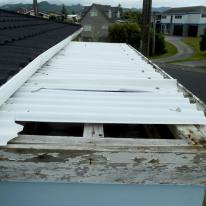Translucent sheet roofing – impact damage
Listed under: Roof, cladding, wind, roof cladding, translucent sheets
Cause
Hail, high winds
Repair
-
older translucent sheet roofing can become brittle from a long time of UV exposure, making it more vulnerable to hail or wind damage. Extreme weather events can damage even relatively new translucent sheet roofing, however
-
because translucent sheet roofing is only used over open areas of houses (decks, verandahs, entrances, covered walkways, carports) it does not have the same weathertight requirements as ordinary roofing. If the impact damage is not obvious and has no effect on the use of the space beneath, action may not be required, or you could experiment with refixing the roofing or using appropriate sealant or patches on the damaged area to stop the rain getting through
-
if the damage is visually unacceptable, or it allows rain to get through to the area beneath, then some or all of the sheets may need to be replaced. If the sheets have yellowed or become opaque with age, replacing all of them may be the best option
-
there is a wide range of products on the market. The traditional translucent profiled sheet roofing, typically with a corrugated profile, is still available. Flat acrylic sheets that look like glass, but weigh a lot less than glass, are also available. Both of these are produced in clear acrylic (which allows the greatest transmission of light and heat) as well as grey or bronze tints that reduce the light and heat passing through
-
the roofing comes with aluminium extruded accessories (rails, end caps, span bars etc.) and flashings folded from aluminium or galvanised steel
-
the roofing usually requires a roof pitch no less than 3° and no more than 30°
-
some manufacturers say their sheeting will expand/contract up to 5 mm per metre on temperature changes. Installation instructions address this. Tapes are provided for under the sheeting to reduce creaking sounds
-
follow the installation instructions of the manufacturer
-
clean translucent roofing with warm soapy water and a soft cloth. This may not be sufficient for lichen – follow the manufacturer’s recommendation
Cause
Attempting to walk on the roof
Repair
- most translucent sheet roofing is not designed to support foot traffic or the storage of heavy objects. Follow the guidance in the repair above and adhere to the roofing manufacturer’s instructions, to use the fixings they specify and to install them in the way they describe
Cause
Weathering resulting in a loss of impact resistance
Repair
- replacement will probably be necessary – as in the first repair above





